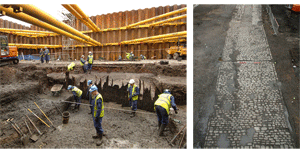
(Courtesy The Museum of London and Pre-Construct Archaeology)
Part of the story of the area's rise to become London's industrial heart is told by the Olympic Park's deepest excavation, at Temple Mills, an area named after the Knights Templar, who owned two water mills there in the twelfth century. The mills were still in use at the end of the sixteenth century, when they were joined by a leather mill, a gunpowder mill (until it blew up), and mills for grinding corn and rapeseed, plus calico printers, flock-makers, and dye houses. From the mid-nineteenth century, industrialization in the Lea Valley intensified. More and more industries developed farther down the valley at Stratford, including paper, tar, and printing works, and chemical manufacturing, all of which had been forced out of central London under new cleaner-living legislation. Digging at Temple Mills was hard going—this part of the site was particularly waterlogged, contaminated by industrial waste, and deeply buried under almost 30 feet of recent landfill. However, the finds were plentiful, and included the frontage of an entire terrace of six workers' cottages that were occupied in the late eighteenth and through the nineteenth centuries. Just as in the Bronze Age, it seems the locals, some of whom are named in extant census records, still chose to live near where they worked.
More London 2012: Archaeology and the Olympics

